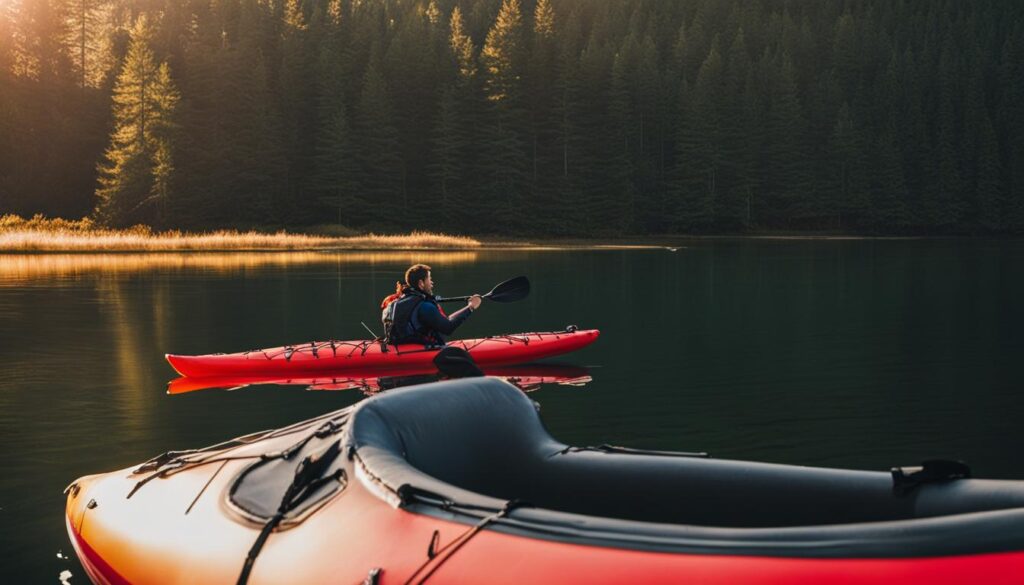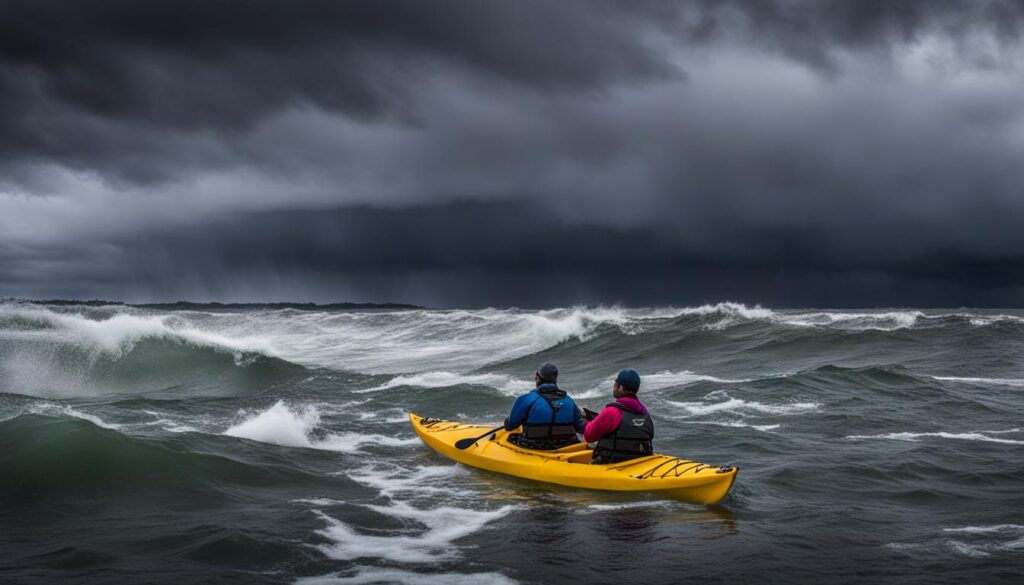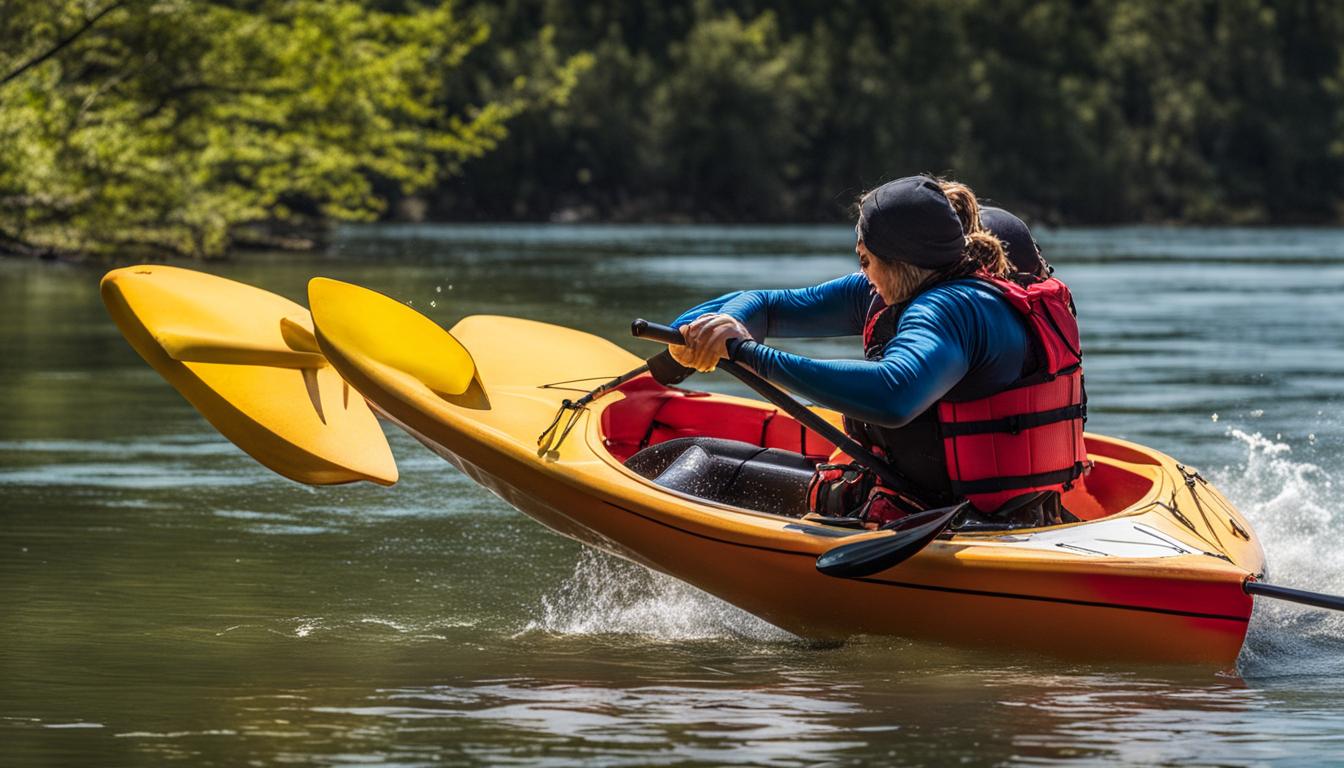In the event of a kayak capsize, it is important to remain calm and follow a step-by-step process to re-enter your kayak safely. Wearing a PFD and practicing beforehand are essential for a fast and simple re-entry. The correct re-entry method differs for sit-on-top and sit-inside kayaks.
For sit-on-top kayaks, position yourself in the middle of the overturned kayak, boost your body over the top, and slowly pull the kayak towards you as you slide back into the water. For sit-inside kayaks, there are two options: follow the same method as a sit-on-top kayak or swim underneath the kayak and quickly push it over. Once back in the kayak, ensure stability and remove any excess water using a bilge pump and sponge. Practice these recovery methods in calm waters to become familiar with the process.
Key Takeaways:
- Remain calm and follow a step-by-step process to re-enter your kayak safely after a capsize.
- Wearing a PFD and practicing beforehand are essential for a fast and simple re-entry.
- The correct re-entry method differs for sit-on-top and sit-inside kayaks.
- For sit-on-top kayaks, boost your body over the top and pull the kayak towards you.
- For sit-inside kayaks, you can either follow the sit-on-top method or swim underneath the kayak and push it over.
- Ensure stability and remove excess water using a bilge pump and sponge.
- Practice these re-entry methods in calm waters to become familiar and confident.
Choosing the Right Kayak for Re-Entry
When it comes to choosing a kayak for re-entry after a capsize, several factors should be taken into consideration. The design of the kayak plays a crucial role in determining the ease of re-entry and overall safety. If you’re planning on embarking on solo kayak adventures, it’s important to select a kayak that suits your needs and skill level.
Width and depth are key considerations when choosing a kayak for re-entry. Wider and deeper kayaks offer greater stability, which is especially important when you find yourself in the midst of a capsize situation. Additionally, the dimensions of the cockpit should be considered, as larger cockpits make it easier to enter and exit the kayak swiftly.
Another important factor to consider is the type of kayak. Sit-on-top kayaks are generally more beginner-friendly and less likely to trap you in a capsize, making them a popular choice for those new to kayaking. On the other hand, sit-inside kayaks offer better control and performance, making them a preferred choice for more experienced kayakers.
| Factors to Consider | Sit-on-Top Kayaks | Sit-Inside Kayaks |
|---|---|---|
| Stability | High stability due to wider design | Stability can vary based on design |
| Entry/Exit Ease | Easy to enter and exit due to open design | May require additional practice for smooth entry/exit |
| Control and Performance | May sacrifice some control and speed | Offers better control and performance |
Remember to choose a kayak that fits your body size and weight. It’s also recommended to consider additional accessories such as paddle floats, bilge pumps, and sponges to aid in re-entry. By selecting the right kayak and accessories, you can ensure a safer and more enjoyable kayaking experience.
Essential Skills for Solo Kayak Re-Entry
In order to confidently navigate rough waters and sea kayaking scenarios, it is crucial to master essential skills for solo kayak re-entry. These skills will not only enhance your safety on the water but also give you the confidence to handle capsizes effectively.
1. Wet Exit:
The first essential skill to master is the wet exit. This involves safely and quickly escaping from your kayak in the event of a capsize. Practice this skill in calm waters, ensuring you can smoothly exit your kayak while remaining calm and in control.
2. Kayak Roll Technique:
The kayak roll technique is another vital skill to learn as it allows you to right your capsized kayak while remaining seated inside. This technique requires practice and can be challenging to master, but it is incredibly useful in rough waters or situations where a quick re-entry is necessary.
3. Effective Paddling Strokes:
Mastering efficient and effective paddling strokes will not only improve your overall kayaking experience but also aid in re-entry. By understanding how to maneuver your kayak and control your direction, you can safely navigate and re-enter your kayak in various water conditions.
4. Boat Re-Entry:
Practicing boat re-entry exercises is essential for solo kayak re-entry. Whether you choose the paddle float method or the cowboy scramble technique, regular practice will build your confidence and help you execute a successful re-entry when it matters most.
5. Navigation Skills:
Basic navigation skills are crucial for sea kayaking and rough waters. Understanding how to read maps, use a compass, and navigate using natural landmarks will ensure you can safely return to shore after a capsize and re-entry.
By mastering these essential skills through proper training and practice, you can confidently handle solo kayak re-entry in a variety of challenging situations. Remember to always prioritize safety, wear appropriate gear, and practice in controlled environments before venturing out into more demanding waters.
Safety Precautions for Kayak Re-Entry
When it comes to kayak re-entry, safety should always be a priority. By following a few quick tips, you can ensure a safe and successful re-entry after a capsize. Here are some important safety precautions to keep in mind:
- Wear a properly fitted PFD (personal flotation device) at all times. This will enhance your buoyancy and provide added safety in case of emergencies.
- Dress appropriately for kayaking, taking into consideration the water temperature and weather conditions. Wearing the right clothing and protective gear can help prevent hypothermia and other cold-related injuries.
- Stay aware of your surroundings and take note of any potential hazards or obstacles in the water. Being vigilant and observant can help you avoid accidents and navigate safely.
For those paddling in a double kayak, it’s essential to develop re-entry strategies that involve teamwork and effective communication. Discuss and practice different techniques with your partner to ensure a smooth re-entry process.
Remember, safety should always come first. Take the necessary precautions and be prepared for anything that may occur during your kayaking adventures.
| Safety Precautions | Benefits |
|---|---|
| Wear a properly fitted PFD | Enhanced buoyancy and safety in emergencies |
| Dress appropriately for kayaking | Prevent cold-related injuries |
| Stay aware of surroundings | Avoid accidents and navigate safely |
By following these safety precautions and being prepared, you can confidently handle kayak re-entry situations and enjoy a safe and enjoyable paddling experience.

The Process of Solo Re-Entry in a Sit-In Kayak
When it comes to re-entering a sit-in kayak solo, there are specific techniques and safety measures to keep in mind. Preparation is key, so ensure you are wearing a properly fitted PFD and are familiar with your kayak’s design. In the event of a capsize, it’s important to remain calm and follow the proper technique for a smooth exit.
First, take a moment to float and assess the situation. Position yourself safely and evaluate water conditions before attempting to re-enter the kayak. When you’re ready to get back in, there are two techniques you can consider: the paddle float method and the cowboy scramble technique.
The paddle float method involves using an inflatable device, known as a paddle float, to provide stability while re-entering the kayak. It’s a technique suitable for cold water conditions. On the other hand, the cowboy scramble technique requires pulling yourself up onto the kayak from the rear. This method is often used in warmer water conditions or when the paddle float is not available. Both techniques require practice and an understanding of the necessary steps to ensure a successful re-entry.
Mastering these solo re-entry techniques will give you the confidence to handle capsizes and safely get back into your kayak. Remember to always prioritize safety and practice in various conditions to enhance your skills.

Double Kayak Re-Entry Strategies
While this section focuses on solo re-entry, it’s important to briefly touch upon double kayak re-entry strategies. When paddling with a partner, communication and teamwork are essential. In the event of a capsize, both paddlers should work together to quickly and efficiently re-enter the kayak.
One effective strategy is the “T-rescue” method, where one paddler stabilizes the capsized kayak while the other paddler re-enters from the side. Proper communication and coordination are key to successfully executing this strategy. It is also important to practice double kayak re-entry techniques with your paddling partner to ensure smooth and safe execution.
By mastering both solo and double kayak re-entry strategies, you can confidently navigate a variety of water conditions and enjoy a safe and thrilling paddling experience.
Master the Art of Kayak Re-Entry for a Confident Paddling Experience
Now that you have learned the step-by-step kayak re-entry process, it’s time to master the art of re-entry for a confident paddling experience. To enhance your skills, consider incorporating kayak re-entry training exercises into your routine. These exercises will help you become more comfortable and proficient in re-entering your kayak after a capsize.
One important aspect to focus on is kayak re-entry in cold water. Cold water presents unique challenges, including decreased dexterity and an increased risk of hypothermia. By practicing re-entry exercises in cold water conditions, you can prepare yourself for unexpected situations and develop the skills needed to navigate these challenging environments.
Furthermore, if you are interested in sea kayaking, it is essential to hone your re-entry skills specifically for this type of kayaking. Sea kayaking often involves rough waters and unpredictable conditions. By practicing re-entry techniques tailored to sea kayaking scenarios, you can build the confidence and ability to handle challenging situations and ensure your safety on the water.
Remember, regular practice, taking part in kayaking classes, and gaining experience in different conditions are key to mastering kayak re-entry. By investing time and effort into your training, you can navigate any capsize with ease, enjoying the thrill and tranquility of paddling in various water environments.
FAQ
What should I do if my kayak capsizes?
Remain calm and follow a step-by-step process to re-enter your kayak safely. Wearing a PFD and practicing beforehand are essential for a fast and simple re-entry. The correct re-entry method differs for sit-on-top and sit-inside kayaks.
How do I re-enter a sit-on-top kayak after a capsize?
Position yourself in the middle of the overturned kayak, boost your body over the top, and slowly pull the kayak towards you as you slide back into the water.
What are the options for re-entering a sit-inside kayak?
There are two options: follow the same method as a sit-on-top kayak or swim underneath the kayak and quickly push it over.
What factors should I consider when choosing a kayak for re-entry?
Factors such as width, depth, cockpit dimensions, and the type of kayak (sit-on-top or sit-inside) should be considered when choosing a kayak for re-entry. Wider and deeper kayaks provide greater stability, while larger cockpits make it easier to enter and exit the kayak.
What essential skills should I master for a solo kayak re-entry?
Mastering essential skills such as performing a wet exit and learning the kayak roll technique can help you successfully re-enter your kayak. Taking beginner kayaking classes can help you learn these skills and other techniques like effective paddling strokes, boat re-entry, and basic navigation.
What safety precautions should I take during kayak re-entry?
Wearing a properly fitted PFD, dressing appropriately for kayaking, and staying aware of your surroundings are important safety precautions to take during kayak re-entry. For double kayaks, developing re-entry strategies that involve teamwork and communication is crucial.
What techniques can I use to re-enter a sit-in kayak alone?
When re-entering a sit-in kayak alone, you can choose between the paddle float method, using an inflatable device for stability, or the cowboy scramble technique, which involves pulling yourself up onto the kayak from the rear.





